Low interest rates to stay in foreseeable future
Updated: 2010-08-21 06:30
By Wang Guanyi(HK Edition)
|
|||||||||
The low interest rate environment will remain for the foreseeable future with recent economic data underlining the choppy and fragile state of the US economy.
As expected, the Federal Open Market Committee (FOMC) concluded after last week to maintain the target Fed Fund Rate at 0-0.25 percent. The statement released after the meeting hinted to a possible easing in the foreseeable future, with the Fed softening its tone on the economic outlook, saying the pace of recovery in output and employment has slowed down in recent months.
The Fed's decision to reinvest repayments from agency debt and agency mortgage-backed securities (MBS) in longer-term Treasury securities sounds like a compromise to hawkish members of the board. Nevertheless, the size of the $2 trillion of MBS in the Fed's balance sheet will remain unchanged.

Although the Fed did not expand the extent of the quantitative easing and restart the money printing machine as it did previously when it purchased $1.25 trillion of MBS and $200 billion of agency debt. It is obvious that the low interest rate environment will remain for the foreseeable future.
Recent economic data has shown the US economy has been choppy and fragile since the FOMC meeting in June. Consumer spending is weak and the manufacturing sector has also lost its momentum after inventory piled up.
The pace of recovery was put in doubt when GDP growth slowed down from a pace of 3.7 percent in the first quarter to 2.4 percent in the second and consumer spending which accounts for approximate 70 percent of the GDP also slowed down from 1.9 percent growth in the first quarter to 1.6 percent in the second.
The new jobless claims hitting a six-month high show the core of the problem.
The unemployment rate has shot up to around 10 percent from the 4.5 percent before the sub-prime crisis. After implementing of its largest fiscal and monetary stimulus, the US unemployment rate remains close to 9.5 percent.
As the pace of recovery slows down, companies are waiting on the sidelines before hiring more staff. As the economy failed to create new jobs, the 8 percent jobless rate that the Obama administration has promised now seems idealistic.
The billions of dollar injected into the economy after the crisis has not significantly lightened the burden for US consumers. The household debt service ratio - the ratio of debt payments over disposable personal incomes - was 70 percent before the crisis, peaked at 131 percent in mid-2007 and dropped only to 122 percent. With a sluggish job market and a high debt level, the spending appetite of consumers is unlikely to turnaround in the near term.
As the effect of the stimulus package begins to fade and the possibility of deflation looms, dovish members within the FOMC will continue to dominate.
As hinted in the Fed statement last week, the danger is of a possible Japanese-style deflation rather than inflation. It is very likely that the Fed will roll out the second round of quantitative easing within the next six months if economic data continues to show a trapped economy.
The author is a visiting professor at the Asian International Open University, an International Financial Commentator at NOW Business News Channel and founder of www.wongsir.com.hk.
(HK Edition 08/21/2010 page2)